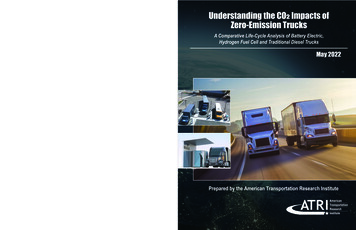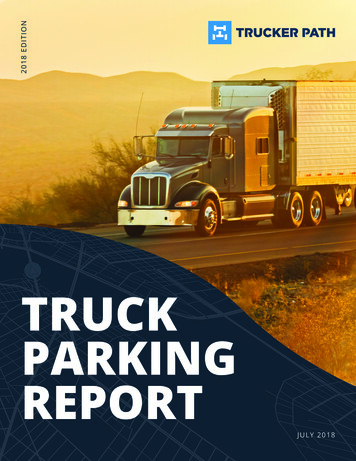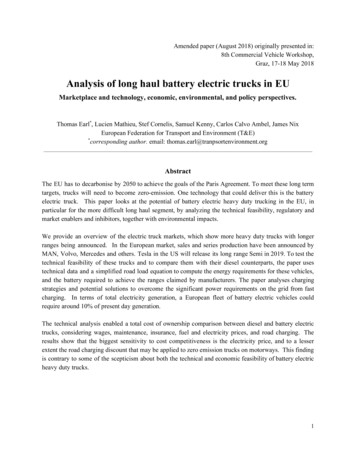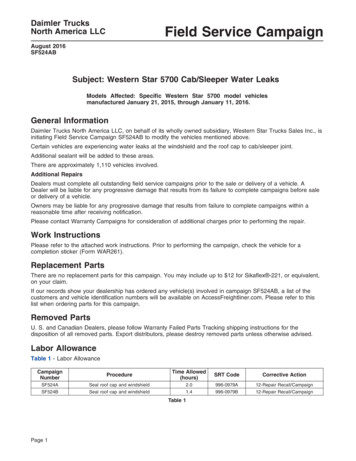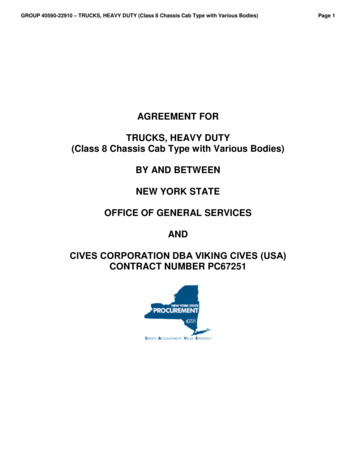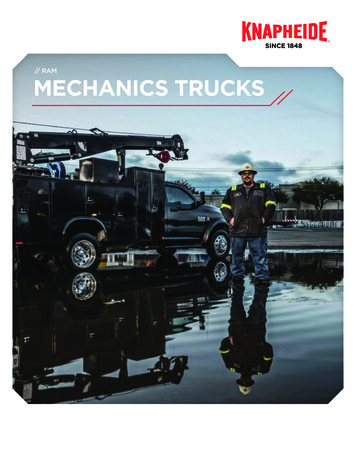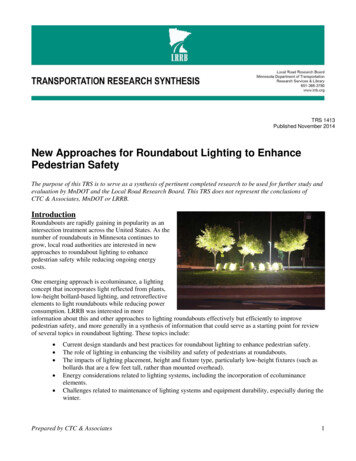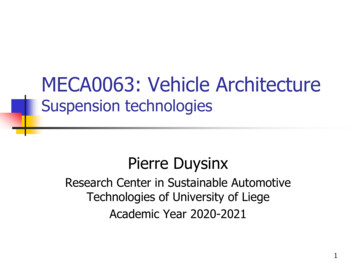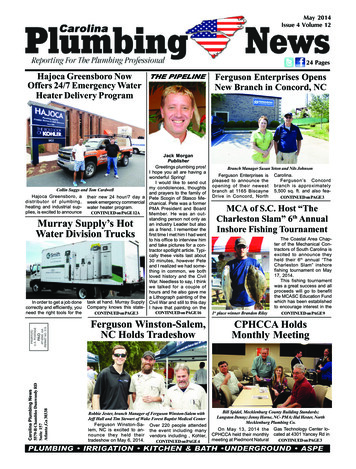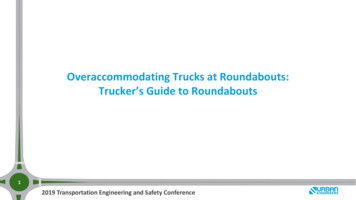
Transcription
Overaccommodating Trucks at Roundabouts:Trucker’s Guide to Roundabouts12019 Transportation Engineering and Safety Conference
AgendaI.II.III.IV.V.Controlling SpeedsDesign VehicleTruck ApronsSmaller Inscribed Circular DiameterGrades and Cross Slopes22019 Transportation Engineering and Safety Conference
I. Large Vehicles Compete with Speed ControlRoundabout design balances two mainfactors: Design Vehicles Fastest PathsSource: FHWA Roundabouts: An Informational Guide32019 Transportation Engineering and Safety ConferenceSource: AASHTO Green Book 2011
Which Truck should be modeled? “I like roundabouts but there’s too much truck traffic”“Use a WB-67; it’s the largest in the AASHTO Green Book”“The truck percentage is low; Use a WB-50”“AutoTurn is ultra conservative”“The truck apron is never driven on”“There are 53’ trailers; Use a WB-67”“Use the largest vehicle that can currently physically make it”Problem Statement:Why doesn’t the modelled vehicle match what is observed in the field?42019 Transportation Engineering and Safety Conference
II. Design VehicleAASHTO Green Book 2018Section 2.8.1 General Characteristics “In the design of any roadway facility, the designer should consider thelargest design vehicle that is likely to use that facility with considerablefrequency or a design vehicle with special characteristics appropriate to aparticular location in determining the design of such critical features atintersections and radii of turning roadways.” “For the purposes of geometric design, each design vehicle has largerphysical dimensions . . . than most vehicles in its class.”52019 Transportation Engineering and Safety Conference
Anatomy of a TruckTractor/CabTrailerKingpin/Fifth WheelRear AxleGroupWheel Base62019 Transportation Engineering and Safety Conference
Trailer LengthPennsylvania Vehicle CodePA Title 75 Chapter 49 § 4923-b.1 Combinations (1) The length of a single trailer being towed by a truck or truck tractor shall notexceed 53 feet. Truck or truck tractors towing trailers equipped with a kingpinshall not be operated when the distance between the kingpin and the center lineof the rear axle or rear axle group exceeds 41 feet or, in the case of a trailer usedexclusively or primarily to transport vehicles in connection with motor sportscompetition events, does not exceed 46 feet.72019 Transportation Engineering and Safety Conference
AASHTO Green Book 2018The WB-67 [WB-20] truck should generally be the minimum size design vehicle. . . . . In many cases, operators of WB-67 [WB-20] and larger vehicles pull the rearaxles of the vehicle forward to maintain a kingpin-to-rear-axle distance of 41 ft[12.5 m], which makes the truck more maneuverable and is required by law inmany jurisdictions. Where the practice is prevalent, the WB 62 [WB 19] may beused in design for turning maneuvers, but the WB-67 [WB-20] should be used indesign situations where the overall length of the vehicle is considered, such as forsight distance at railroad-highway grade crossings.82019 Transportation Engineering and Safety Conference
Tractor/Cab Sizes vary based upon use Day cab vs night cab WB-62 and WB-67 is the mostconservative tractor As autonomous trucks areadopted, cabs will becomeshorterCreator: Petter BergCopyright: Photographer Petter BergCourtesyofAASHTONick Pugh/20CenturySource:GreenthBook2011Fox92019 Transportation Engineering and Safety Conference
Modified WB-62102019 Transportation Engineering and Safety Conference
Confirming the use of a WB-62112019 Transportation Engineering and Safety Conference
Washington State DOT – Design Vehicles122019 Transportation Engineering and Safety Conference
Washington State DOT - AutoTurn132019 Transportation Engineering and Safety Conference
Accommodating Tight Truck Turns142019 Transportation Engineering and Safety Conference
Outside Truck Aprons Use as a last resortComplicate modellingADA concernsDWS placementCrosswalk ponding152019 Transportation Engineering and Safety Conference
III. Truck Aprons Cross slope (1%-2%) Low boys and OSOW vehicles Address Overtipping/load shiftconcerns Discourage use by carsSource: PennDOT RC-65M162019 Transportation Engineering and Safety Conference
Washington State DOT Mountable CurbsSource: WSDOT Standard Plan F-10.18.01172019 Transportation Engineering and Safety ConferenceSource: WSDOT Standard Plan F-10.18.01
IV. Inscribed Circular Diameter ICD determined by designvehicle Accommodate vs designed forSource: WSDOT Design Manual M 22-01.17 Chapter 1320Source: NCHRP 672, 2nd EditionSource: WisDOT Design Manual FDM 11-26182019 Transportation Engineering and Safety Conference
Smaller Inscribed Circular Diameter192019 Transportation Engineering and Safety Conference
Planning and Growth202019 Transportation Engineering and Safety Conference
Truck CasesCase ICase IISource: WisDOT FDM 11-26 Roundabouts212019 Transportation Engineering and Safety ConferenceCase III
WashDOT Trucks at Multilane Entrances Trucks take both lanesBox out each entranceKeep vehicles out of blind spotAvoid truck apron completelySimulate at 5 mphSource: WSDOT Design Manual M 22-01.17 Chapter 1320222019 Transportation Engineering and Safety Conference
V. Vertical Grades and Cross SlopesIn is generally not desirable to place roundabouts in locations where gradesthrough the intersection are greater than 4%, although roundabouts havebeen installed on grades of 10% or more.-NCHRP 672, 2nd Edition232019 Transportation Engineering and Safety Conference
Washington State DOT – Steep Profile242019 Transportation Engineering and Safety Conference
Cross SlopesSource: WSDOT Design Manual M 22-01.17 Chapter 1320252019 Transportation Engineering and Safety Conference
WSDOT Lesson Learned262019 Transportation Engineering and Safety Conference
Thank youMichael P. Mastaglio, PE, PTOEAndrew A. Thompson, EITBrian Walsh, PEUrban Engineers, Incmpmastaglio@urbanengineers.com(215) 922-8080Urban Engineers, Incaathompson@urbanengineers.com(215) 922-8080Washington State DOTWalshB@wsdot.wa.gov272019 Transportation Engineering and Safety Conference
The WB-67 [WB-20] truck should generally be the minimum size design vehicle. . . . . In many cases, operators of WB -67 [WB-20] and larger vehicles pull the rear axles of the vehicle forward to maintain a kingpin- to-rear-axle distance of 41 ft [12.5 m], which makes the truck more maneuverable and is required by law in many jurisdictions.

